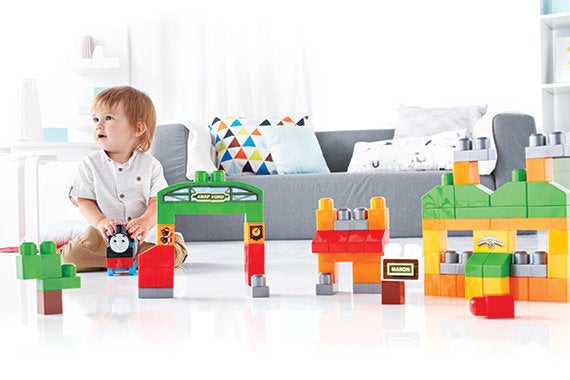
Play is a fundamental part of a happy childhood. But when children are immersed in play, they’re not simply having a lovely time, they are honing key life skills.
Research shows that early years play is essential to children’s physical and social development, emotional wellbeing, imagination and creativity and even their language skills and later academic achievement.
Playing with objects begins as soon as babies can grasp and hold on to them, and involves biting them, hitting them and dropping them (again and again!).
This exploration of objects becomes more sophisticated from the age of 18 months to two years when toddlers begin to arrange objects, like bricks and coloured pots, and by the age of three and four they will love building together with the imaginative storytelling that goes with their constructions.
Building blocks have been the favourite toys for generations of children, and with good reason. Nicola Butler, chair of Play England, the national children’s play charity, says part of their continued appeal is that these block stimulate creativity and provide limitless possibilities in small hands.
“Children love building blocks because there’s no right or wrong way to use them, especially compared to tech games which are often prescriptive and repetitive, doing the same thing over and over again,” she says.
“The joy of building a tower and knocking it down again gives children huge fun and freedom, especially because there aren’t many times when they’re allowed to knock things over again and again.
“But building bricks can be used any way your child chooses in ‘free play’ and all the time they’re improving your child’s hand-eye coordination, problem solving, creativity and imagination,” Nicola concludes.
Play experts agree the best way for children to play - and learn - is through imaginative, unstructured playing.
This free play gives your child opportunities to create and imagine without a specific end result and this is best done by using toys that can be manipulated and transformed into whatever they desire. There are no set rules to follow, just the fun of playing and exploring.
For example, the same building blocks can become whatever your child desires at that particular time - a tower, a train, a home for other toys, whatever they want.
“My children have always loved building blocks, from the baby years when they’d be intent on banging and chewing a few blocks on their highchair table to whole afternoons spent creating whole towns,” says mum-of-three Estelle.
“I think the bright colours and smooth, unbreakable textures appeal as a starting point and then they simply have limitless possibilities.”
Extending fine motor skills and dexterity
Blocks come in a wide range of shapes and sizes, ideal for tiny hands to practise assembling and pulling apart. These twists and turns with their hands, fingers and arms promote fine motor skills which they’ll continue to use from learning to write to doing up fiddly buttons. Nothing beats hands-on learning.
Building patience and self-confidence
A child who is entirely focussed on creating something new is taking on hugely important life lessons like patience, persistence and the importance of learning through trial and error. And you’ll see confidence grow too, with every extra block added, every teetering taller tower or more complicated building.
Developing problem-solving abilities
When your child is working out what shapes fit together or sizes balance best, they are learning how to think for themselves, experiment and solve problems - the exact same skills that are the building blocks to becoming independent, resourceful adults who relish a challenge.
Constructing imaginative stories
Kids aren’t simply constructing a physical building, they are creating an imaginary world where anything can happen and they’re in charge. ‘Let’s pretend’ is one of the best ways children can develop their language and social skills.
Laying the foundations for friendship
“Building blocks are ideal when children are just beginning to play with each other, rather than simply alongside each other,” says mum-of-two Julie. “It’s fascinating to see the transition from shyly noticing what the other child’s doing, to lending a hand to actually working together, chatting all the time about what they’re going to build.
“Bricks are one of the best toys for playdates, especially on rainy days. They’re ideal toys for sharing too - I’ve yet to find a child who’s fixated on one brick and won’t let anyone else play with it.”
And, of course, when it doesn’t go to plan and a tower collapses (or is deliberately pushed over), your child’s discovering the joy of starting all over again to maybe build something even more exciting.
Help children build big imaginations one block at a time with Mega Bloks Thomas & Friends.
A great way to encourage creativity, building toys let kids shape the worlds they imagine and tell stories that are truly their own. These big Mega Bloks Thomas & Friends for small hands let children practice problem solving and fine motor skills, using the same pieces to build something completely different and create new stories with Thomas every day.
type=type=RelatedArticlesblockTitle=See Also: + articlesList=58d046bce4b0ec9d29de9f63,58c576efe4b0ed71826d3c27